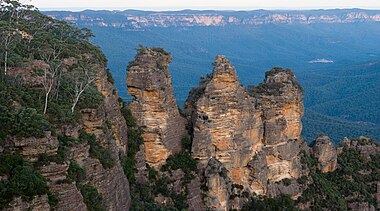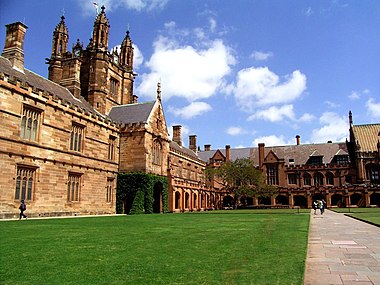Portal:New South Wales/Selected picture/Archives
Replace "$" with the month you want to create
Selected pictures in 2007
[edit]December
[edit]
The koala is found in coastal regions of eastern and southern Australia, from near Adelaide to the southern part of Cape York Peninsula. Populations also extend for considerable distances inland in regions with enough moisture to support suitable woodlands. The koala is the national animal emblem of New South Wales.
Selected pictures in 2008
[edit]January
[edit]
Bondi Beach is a popular beach and the name of the surrounding suburb in Sydney, Australia.
February
[edit]
Central Coast Stadium is a sports venue on Grahame Park in Gosford, on the Central Coast of New South Wales. Originally designed to be the home stadium for the North Sydney Bears rugby league football club, the stadium is now home to the Central Coast Mariners Football Club and Rays rugby union club.
March
[edit]
The Blue Mountains of New South Wales, Australia, are situated approximately 100 kilometres west of Sydney. They are a range of sandstone geological structures that reach to at least 1,190 metres AHD.
April
[edit]
Telopea speciosissima, commonly known as the "New South Wales Waratah" or simply "Waratah", is a large shrub in the Proteaceae family. It is endemic to New South Wales in Australia and is the floral emblem of that state. It is renowned for its striking large crimson flowerheads in spring.
May
[edit]
New Year's Eve in Australia is celebrated with public events in most major centres. Celebrations typically include substantial fireworks displays and musical entertainment. The New Year's Eve event in Sydney is one of the largest celebrations in the world, with in excess of one million people gathering at vantage points around Sydney Harbour to view a fireworks display centred on the Sydney Harbour Bridge.
June
[edit]
The University of Sydney, established in Sydney in 1850, is the oldest university in Australia. It is a member of Australia's "Group of Eight" Australian universities that are highly ranked in terms of their research performance, and is one of the country's most prestigious educational institutions. In 2005, the University of Sydney had 45,966 students and 2,300 (full-time equivalent) academic staff, making it the second largest in Australia. The university's main campus has Oxbridge-inspired grounds and is situated in the south-west of the Sydney central business district.
July
[edit]
Luna Park Sydney (originally Luna Park Milsons Point, now formally Sydney's Luna Park) is a historical amusement park, located on the northern shore of Sydney Harbour in Sydney. The heritage-listed park first opened in 1935, and is open for business as of 2013[update], but over its 70-year history, the park has experienced multiple closures, changes of ownership, legal battles, and community action in both support of and opposition to Luna Park's operation.
August
[edit]
Taronga Zoo is the zoological park of the city of Sydney. Founded in 1916, it is located on the shores of Sydney Harbour in Mosman. It is divided into eight zoogeographic regions and features over 2,600 animals on 28.7 hectares, making it one of the largest zoos of its kind.
September
[edit]
The Sydney Opera House is situated on Bennelong Point in Sydney Harbour, close to the Sydney Harbour Bridge. It is one of the world's most distinctive 20th century buildings, and one of its most famous performing arts venues. It was made a UNESCO World Heritage Site on June 28, 2007.
October
[edit]
The Australian 4th Division was formed in the First World War during the expansion of the Australian Imperial Force infantry brigades in February 1916.
On 11 April 1917 the Fourth Division assaulted the Hindenburg Line in the First Battle of Bullecourt. The battle was a disaster and 1170 Australian prisoners were taken by the Germans. In June it participated in the Battle of Messines. In September it participated in the Battle of Polygon Wood.
The photo depicts soldiers from the New South Wales-based 45th Battalion of the Division during the Hindenburg Line assault.
November
[edit]
The Japanese garden in Cowra is a living reminder of the historic link between the town and the people of Japan, arising from the Cowra breakout by Japanese prisoners of war during World War Two. At five hectares, the Cowra Japanese Garden is the largest Japanese garden in the Southern Hemisphere. An annual Sakura Matsuri (cherry blossom festival) is held in the gardens during late September and/or early October each year.
December
[edit]
The Australian Pelican (Pelecanus conspicillatus) is a large water bird, widespread on the inland and coastal waters of Australia and New Guinea, also in Fiji, parts of Indonesia and as a vagrant to New Zealand.
In 1999 the waterfront at The Entrance, New South Wales was named 'The Pelican Capital of Australia' by Wyong Shire Council to coincide with the opening of a pelican feeding platform as part of the waterfront redevelopment.
